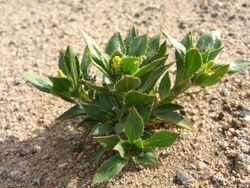Biology:Stillingia spinulosa
| Stillingia spinulosa | |
|---|---|

| |
| Scientific classification | |
| Kingdom: | Plantae |
| Clade: | Tracheophytes |
| Clade: | Angiosperms |
| Clade: | Eudicots |
| Clade: | Rosids |
| Order: | Malpighiales |
| Family: | Euphorbiaceae |
| Genus: | Stillingia |
| Species: | S. spinulosa
|
| Binomial name | |
| Stillingia spinulosa | |
Stillingia spinulosa is a species of flowering plant in the euphorb family known by the common name annual toothleaf.[1] It is native to the Southwestern United States where it occurs in the creosote scrub of the deserts. It is an annual or perennial herb producing a clump of thick, leafy stems approaching a meter in maximum height. The alternately arranged leaves have shiny pointed oval blades 2 to 4 centimeters long and up to 1.2 centimeters wide which are lined with sharp teeth. The inflorescence is a stout spike of flowers 1 to 2 centimeters long. The plant is monoecious, and each spike has several male flowers at the tip and 1 or 2 fruit-bearing female flowers below these. Neither type of flower has petals. The ovary of the female flower develops into a three-lobed greenish capsule about half a centimeter wide. There is a tiny rough-surfaced seed in each of the three chambers of the fruit.
References
- ↑ "Stillingia spinulosa". Natural Resources Conservation Service PLANTS Database. USDA. https://plants.usda.gov/core/profile?symbol=STSP. Retrieved 3 December 2015.
External links
Wikidata ☰ Q7617246 entry
 |

